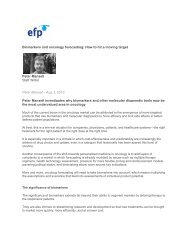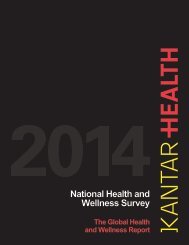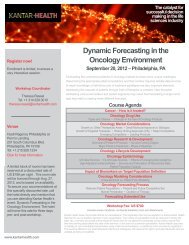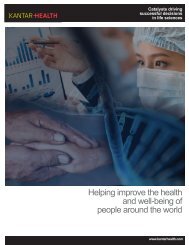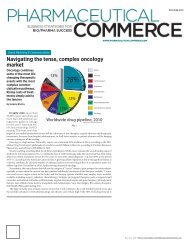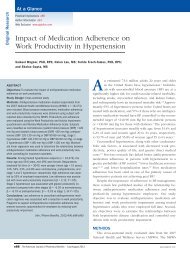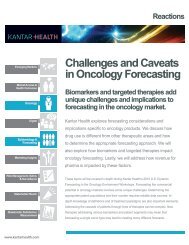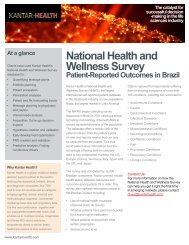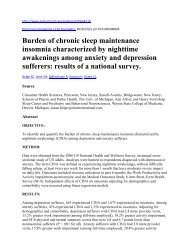First mover advantage - Kantar Health
First mover advantage - Kantar Health
First mover advantage - Kantar Health
Create successful ePaper yourself
Turn your PDF publications into a flip-book with our unique Google optimized e-Paper software.
ONCOLOGY – ASCO 2012<strong>First</strong> <strong>mover</strong><strong>advantage</strong>Companies with enhanced strategic planning andcareful forethought in structuring clinical trials willmaximise opportunities in the oncology marketIn the crowded therapeutics market for managing patientswith renal cell carcinoma (RCC), there are seven agents(excluding cytokines) currently approved for use, five ofwhich are approved for use in the first-line setting, withfour of these being VEGF pathway inhibitors. With so manyoptions, and few definitively differentiating factors, how is aphysician (or patient) to choose the best course of therapy?Perhaps in anticipation of this, GlaxoSmithKline took thebold move of initiating a patient preference study shortlyafter gaining regulatory approval for Votrient in advancedor metastatic RCC. The PISCES trial randomised patients tosequential treatment with Votrient (10 weeks) followed bySutent (10 weeks) and vice versa, and patients completedpreference questionnaires at the end of each treatment period.This unique design allowed direct evaluation of drug preferenceamong patients who had been equally exposed to both agents.The results, presented at an Oral Genitourinary Cancerssession at ASCO 2012, were overwhelming – 70 per cent ofpatients who completed both treatments and questionnairespreferred Votrient, with just 22 per cent preferring Sutent(8 per cent had no preference). Overall quality of life and allqueried toxicities were cited as favouring Votrient, with theissue of fatigue standing out from the patients’ perspective.Recognising your weaknesses and threats, and leveraging yourstrengths and opportunities is one of the first things taught inbusiness school and should be incorporated into any strategicdevelopment plan. GSK is going out guns blazing in a valiantattempt to position Votrient as the preferred first-line agentfor advanced RCC. Just a few years ago this was a tiny market– almost insignificant in financial terms. Consensus analystprojections now predict that by 2018 the RCC market will have acombined value of $4.0bn, with Avastin, Afinitor, Sutent, Nexavarand Votrient as the top five products (source: EvaluatePharma).TREATING LATE-STAGE DISEASEQuestions about targeted therapy, biomarkers andprogression-free survival (PFS) came thick and fast at ASCO 2012.While impressive data as shown for several compounds questionsfrom the audience as well as the presentation of separateeducational tracks made access to new treatment, affordabilityand policy implications a recurring theme of the meeting.For example, when segmentation of non-small-cell lungcancer (NSCLC) started, it was hailed as a way to limitthe use of an expensive therapy that would ultimatelyprove to be non-effective in the majority of patients.Biomarkers were deemed the wave of the future toidentify the patients most likely to benefit, and clinical trialdata showed impressive response rates in these identifiedpatients. As more subtypes of NSCLC continue to beidentified, the issue being raised is the cost of identifying apatient’s genetic subtype. The cost of a single genetic test(ALK FISH test for crizotinib) is estimated in a 2011 Forbesarticle at approximately $1,500, which includes the cost ofthe test (approximately $250) plus pathology services.An article in the American Journal of Managed Care states:‘While fluorescence in situ hybridisation (FISH) has been the“gold standard” of detecting ALK gene rearrangement, severalclinical trials evince limitations in this method — in terms ofboth cost and effectiveness — and oncologists and othermedical professionals suggest administering a combination ofscreening methods to adequately identify ALK-positive NSCLC.‘Crizotinib (Xalkori), an orally taken ALK inhibitor, iscurrently the only FDA-approved drug treatment for ALKnon-small-cell lung cancer, and since its prescription is entirelycontingent upon positive FISH results, many researcherspromote the standardisation of other screening methods,which could be more accurate and cost efficient.‘Much like its companion FISH test, however, crizotinib comeswith a high cost … and with its reliance on the FISH probe kit asa companion test, the total cost of ALK screening and treatmentwould be prohibitive for many.’ (Beagin K, Testing for ALK-PositiveNSCLC, American Journal of Managed Care, 2012;18(SP3).If protocols are adopted calling for multiplegenetic tests the cost of screening patients couldbecome almost as expensive as therapy.While PFS data continues to be impressive for new late-stagetreatment options, overall survival (OS) has not significantlyincreased. The cost curve of treating patients (The Cost of LungCancer Care: Screening, Personalised Medicine, and PalliativeCare) calculated that 43 per cent of NSCLC care was spent ininitial treatment and 41 per cent of the cost occurred at end of34 www.pmlive.com/pme Pharmaceutical Market Europe October 2012
ONCOLOGY – ASCO 2012life. In parallel, the use of hospice care (Costs of Cancer Care:Affordability, Access, and Policy) is used primarily in the lastweeks of life as patients are often receiving chemotherapytreatment up to their last month. Studies have shown the qualityof life for patients in hospices is higher than those receivingchemotherapy. Does that mean treatment should stop sooner?Unfortunately, the answer is not that simple. Some patientsare willing to accept more toxicity from their treatment thantheir physicians are willing to accept. Payers continue to lookat late-stage and end-of-life treatment to try to find a wayto manage these costs better. This may include requiringphysicians to discuss the various options, including hospicecare earlier in the patient’s treatment. While payer coveragewill affect the decision, patients, along with their physicians,will need to determine what works best for them. The keytakeaway is that treatment will continue to be (and may beeven more so in the future) an individual patient choice.TREATMENT AFFORDABILITYWhile affordability of cancer treatments is an importantissue in industrialised markets, it is a significant challengein the developing world. A key central theme in manyof the presentations during the Affordability of CancerCare: A Global Perspective session at ASCO, was that itis in the global healthcare community’s best intereststo share resources and collaborate on solutions thatproduce sustainable and affordable global cancer care.In his presentation, Cost of New Cancer Treatments inRelation to Their Effectiveness, Ian Tannock, MD, PhD,questioned Western nations’ choice to frame ‘effectiveness’instead of ‘cost effectiveness’ as the main criterion for newdrug approvals. Tannock believes that cost effectivenessis a better metric because it would yield a more equitabledistribution of limited healthcare resources.He went on to recommend that pharma should beincentivised to develop new uses for older cancer drugs boththrough the adoption of cost-effectiveness criteria by theFDA and EMA for drug approvals, and by being allowed torecover their R&D costs for developing these older drugs.In his presentation A Vision of Global Cancer Research in theFuture, Dr Richard Schilsky said industry should move awayfrom large clinical trials that offer only modest improvements.He suggested focusing on clinical trials that have the greatestpotential for patient benefit, and recommends selecting trialparticipants based on use of biomarkers. This gives researchersa better opportunity to demonstrate greater benefits andthereby decrease the associated costs of clinical trials, he said.Schilsky also noted that no single country or stakeholdercan work in isolation while attempting to solve the problemsassociated with the affordability of cancer treatments. Toachieve long-term sustainability and affordability, Schilskybelieves all cancer research and development stakeholdersmust embrace cooperation (versus competition) and recognisethat cooperatively addressing and solving these problemsis in long-term best interests of each stakeholder.CANCER IS BIG BUSINESSWe have made a number of references to the amount of moneymanufacturers might be able to reap and indeed have provideda few examples for consideration. The question that often comesto the fore is: How long can we continue with ever-increasingprices for cancer treatment? The truth is, no one has the answer.In the US the cost of treating cancer is increasing for anumber of reasons, including the disproportionately ageingpopulation and improved technologies that extend life ratherthan provide a cure. Thus, more patients are living longerwith their disease. Oftentimes this extension of life occursin the metastatic stage — the stage of disease characterisedPharmaceutical Market Europe October 2012 www.pmlive.com/pme 35
ONCOLOGY – ASCO 2012by the greatest number of newer, more costly drugs.In the end, we pay for our success. However, there are veryclear signals that ability and willingness to pay are decreasing.Payers are seeking new ways to control costs, includingthe heretofore protected area of cancer. (<strong>Kantar</strong> <strong>Health</strong>Oncology Market Access, <strong>Health</strong>care Reform, Spring 2012.)When considering an emerging market, the issue becomesthat much more complex. Countries like Brazil, Russia,India and China (BRIC) boast a developing middle class,as well as a growing affluent population. More peopleare able to afford basic healthcare than ever before, anda growing segment of the population has access to thelatest premium drug brands (Emerging Markets: Miningthe Opportunities, Stephen Potts, <strong>Kantar</strong> <strong>Health</strong>).According to Forecasting and Market Segmentation inChina (June 2012): ‘Prices for premium innovative products(PIPs) in China can be just as expensive as in the West. Mostof these types of products are not reimbursed and thus fallinto the cash/self-pay segment of the market. For oncologyproducts, the cost may be higher, but possibly more finitethan chronic therapies. We might want to consider overallpotential patient wealth rather than annual income, becausepatients might use savings to pay for the therapy.’Manufacturers need to make the most of opportunitiespresented to them for maximising return on investment.However, in so doing, it is important that they keep in mindthat there appears to be increasing demand for greatervalue for new oncologic (and other) therapeutics and it isfeasible that over time there may be greater governmentalrestrictions on the pricing that the market will need to bear.Enhanced strategic planning and carefulforethought in structuring clinical trials will berequired in order to maximise opportunities.INFORMATION OVERLOADDr George Sledge, co-director of the breast cancer programmeat Indiana University and a past president of ASCO, said of theexponential increase in information and clinical knowledgeregarding cancer: “We’ve had this biological revolutionthat has sliced the pie for these cancers finer and fineras we’ve learned more about the genomics of cancer.”Sledge said he knows of at least 17 differentsubtypes of acute lymphoblastic leukaemia (ALL), themost common type of leukaemia in children. “Eventrying to wrap your head around that is hard.”Writing in journal Oncology (April 17, 2012), Dr Edward PAmbinder noted: ‘We are living in unprecedented times, inwhich oncologists and their patients are facing disruptivechanges in healthcare, research, education, governmentalpolitics, business, communication, and finance – changesbrought on by the individual growth and merging of thefields of information technology, biology, and physics.‘This dramatic increase in the quantity, quality, and easeof finding information – and the effortlessness of connectingeveryone and everything – all of which has been broughtabout by the internet, has changed our lives forever.’Certainly these same dynamics affecting oncologistsand patients also impact manufacturers, payers and allof the other participants within the healthcare system.The AuthorsTony Faustino, Chris Gage, Ian Hicks, Anne LaPrade and Song Li.www.kantarhealth.com or contact our team atwww.kantarhealth.com/contactusEuropaColon initiativeEuropaColon, a pan-European colorectal cancer (CRC)organisation has launched a new initiative – YoungVoices United against Colorectal Cancer – aimed atproviding an online forum for young people affected byCRC to share and exchange information that will helpempower and support them.The global burden of CRC is rising largely due to ageing,growth of the world population and a steady increasein cancer-causing behaviours, particularly smoking, ineconomically developing countries.While CRC is rare in developing countries, it is thesecond most frequent malignancy in affluent societies.In Europe, each year, more than 450,000 people arediagnosed with CRC and about 230,000 will die of thedisease.Unfortunately, it is not just the over 50’s who are at riskof developing CRC. In contrast to the overall decliningrates of this disease, incidence and mortality ratesamong young adults under the age of 50 years are onthe increase.Professor Dr Gabriela Möslein, from the Department ofGeneral and Visceral Surgery, Coloproctology, HeliosSt.Josefs Hospital, Bochum and Past Chairperson ofInSiGHT (International Society for Hereditary ColorectalCancer) said: “CRC is on the increase and mainly affectsthose people 65 years old and above. However, some 5-8per cent of patients will present at a much younger ageand as such have a very different experience due to theiryouth and quite different perspective on life.“I firmly believe Young Voices United against ColorectalCancer will provide a platform for young people to helpthem find comfort, hope and support in the broadestsense and last but not least have access to a network ofprofessionals available to guide them through their ownand their families’ individual risk assessment.”Communicating aspects of CRC, such as individualrisk factors, diagnosis and treatment options and theneed for prevention and early diagnosis, to the oldergeneration has traditionally been hard. And getting themessage out to young adults is even more challenging.EuropaColon’s Survivorship Ambassador MilanDjordjevic of Serbia was diagnosed at the age of just 24years old. “More than 10 years ago I was diagnosed withCRC and I am now a survivor. At that time, I had greatsupport from my family and friends, however I did nothave anyone to talk to who was going through the sameexperience as me. I would like for Young Voices Unitedagainst Colorectal Cancer to become Europe’s largestsupport community for young adults affected by thedisease. Young Voices United aims to provide a uniqueopportunity through this forum by offering programmesand tools which directly address the specific needs ofthis group of people.”Commenting on the initiative, Jola Gore-Booth, CEOand Founder of EuropaColon, said: “I hope all theseyoung people will unite together to form a strong armyof ambassadors and spread the word about the need ofknowing your risks of developing the disease... the needto have a healthier diet and lifestyle, and to be aware ofthe symptoms of the disease.”36 www.pmlive.com/pme Pharmaceutical Market Europe October 2012



